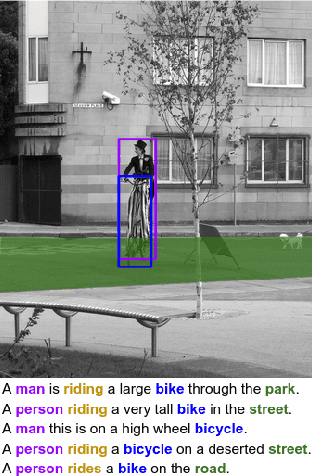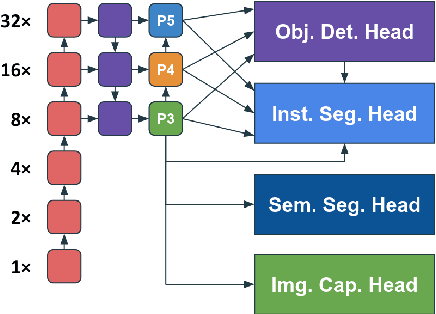Hung-Shuo Chang
YOLOR-Based Multi-Task Learning
Sep 29, 2023



Abstract:Multi-task learning (MTL) aims to learn multiple tasks using a single model and jointly improve all of them assuming generalization and shared semantics. Reducing conflicts between tasks during joint learning is difficult and generally requires careful network design and extremely large models. We propose building on You Only Learn One Representation (YOLOR), a network architecture specifically designed for multitasking. YOLOR leverages both explicit and implicit knowledge, from data observations and learned latents, respectively, to improve a shared representation while minimizing the number of training parameters. However, YOLOR and its follow-up, YOLOv7, only trained two tasks at once. In this paper, we jointly train object detection, instance segmentation, semantic segmentation, and image captioning. We analyze tradeoffs and attempt to maximize sharing of semantic information. Through our architecture and training strategies, we find that our method achieves competitive performance on all tasks while maintaining a low parameter count and without any pre-training. We will release code soon.
NeighborTrack: Improving Single Object Tracking by Bipartite Matching with Neighbor Tracklets
Nov 12, 2022Abstract:We propose a post-processor, called NeighborTrack, that leverages neighbor information of the tracking target to validate and improve single-object tracking (SOT) results. It requires no additional data or retraining. Instead, it uses the confidence score predicted by the backbone SOT network to automatically derive neighbor information and then uses this information to improve the tracking results. When tracking an occluded target, its appearance features are untrustworthy. However, a general siamese network often cannot tell whether the tracked object is occluded by reading the confidence score alone, because it could be misled by neighbors with high confidence scores. Our proposed NeighborTrack takes advantage of unoccluded neighbors' information to reconfirm the tracking target and reduces false tracking when the target is occluded. It not only reduces the impact caused by occlusion, but also fixes tracking problems caused by object appearance changes. NeighborTrack is agnostic to SOT networks and post-processing methods. For the VOT challenge dataset commonly used in short-term object tracking, we improve three famous SOT networks, Ocean, TransT, and OSTrack, by an average of ${1.92\%}$ EAO and ${2.11\%}$ robustness. For the mid- and long-term tracking experiments based on OSTrack, we achieve state-of-the-art ${72.25\%}$ AUC on LaSOT and ${75.7\%}$ AO on GOT-10K.
 Add to Chrome
Add to Chrome Add to Firefox
Add to Firefox Add to Edge
Add to Edge